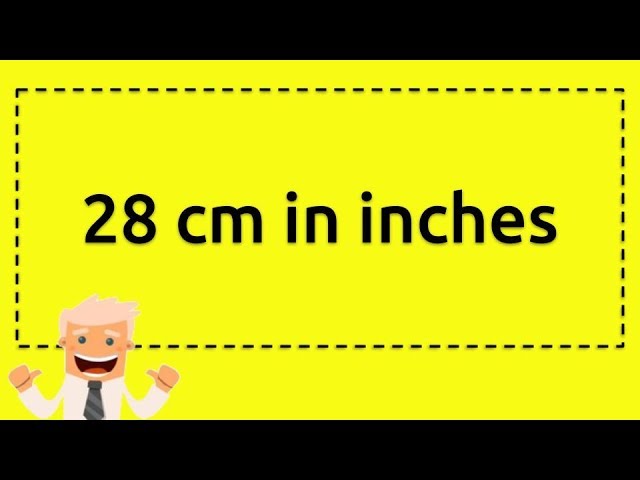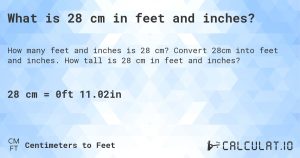By understanding this ratio, you can easily switch between the two units of measurement. To give you an idea, 1 inch is approximately equal to 2.54 centimeters. So, converting 28 cm to inches requires multiplying by a factor that reflects this ratio. Let’s explore the steps and formula in more detail, ensuring that you can convert between the two units quickly and efficiently.
How to Convert Centimeters to Inches
Converting centimeters to inches is a straightforward process that requires applying a simple conversion factor. The key formula you need is:
Inches = Centimeters ÷ 2.54.
This means to convert centimeters to inches, you divide the centimeter value by 2.54. It’s important to note that this factor remains constant across all conversions, so whether you’re converting 28 cm or any other number, the same formula applies. For 28 cm, you’ll divide 28 by 2.54, resulting in the equivalent inches measurement.
This is a quick calculation that ensures precision and consistency. To ensure accuracy, always check the result, especially in contexts like engineering or design, where even small differences can matter. Understanding this method will make it easier to work across different units of measurement.
The Formula for Converting 28 cm to Inches
The formula for converting 28 cm to inches is quite simple and universally applicable:
Inches = Centimeters ÷ 2.54.
This formula relies on the fact that one inch is equal to 2.54 centimeters. To convert 28 cm into inches, you divide 28 by 2.54, resulting in a precise measurement of approximately 11.02 inches. This calculation provides a highly accurate conversion, making it easy to switch between metric and imperial units.
Whether you are measuring length, height, or any other physical dimension, using this formula allows you to convert centimeters to inches quickly and easily. Keep this formula handy, and you’ll always be able to perform accurate conversions whenever needed.
28 cm in Inches: Quick Calculation
If you need a quick calculation for 28 cm to inches, you can use the formula:
Inches = Centimeters ÷ 2.54.
When you divide 28 by 2.54, the result is approximately 11.02 inches. This means that 28 cm is just over 11 inches. This calculation provides an easy and practical solution for converting between centimeters and inches. Knowing this quick conversion is useful in a wide variety of fields, whether you’re working in design, construction, or even when shopping for clothing or furniture. With just a simple calculation, you can make sure that you have the right measurements and can convert units with confidence.
Step-by-Step Guide to Converting 28 cm to Inches
To convert 28 cm to inches, follow these easy steps:
- Start with the known value: You have 28 cm.
- Use the formula: Inches = Centimeters ÷ 2.54.
- Divide 28 by 2.54: 28 ÷ 2.54 = 11.02 inches.
- Check the result: 28 cm is equal to approximately 11.02 inches.
By following these simple steps, you can convert any centimeter value into inches. It’s important to note that the precision of the result will depend on the number of decimal places you include in your calculation. For general purposes, rounding to two decimal places works well, but in specialized fields, you may want to use more digits for increased accuracy. This straightforward guide will help you quickly handle conversions, whether you’re working with 28 cm or any other length.
Understanding the Centimeter and Inch Relationship
The centimeter and inch are both units of length, but they belong to different measurement systems. Centimeters are part of the metric system, which is used widely across the world, while inches are part of the imperial system and are more commonly used in countries like the United States and the UK. Understanding the relationship between these two units is key to accurately converting between them. Specifically, 1 inch is equivalent to 2.54 centimeters.
Therefore, to convert from centimeters to inches, you divide the number of centimeters by 2.54. This relationship is consistent, making conversions between the two units quick and reliable. Whether you are measuring height, length, or any other dimension, understanding this connection is essential for working with different measurement systems.
28 cm to Inches: Practical Examples
Converting 28 cm to inches can be used in various real-life situations. For example, if you’re buying a piece of furniture that’s 28 cm in height and want to know how that translates into inches, you can use the formula:
Inches = Centimeters ÷ 2.54.
Dividing 28 by 2.54 gives you approximately 11.02 inches. This can be helpful when checking whether furniture will fit in a specific space or comparing measurements. Another example is in fashion: if you have a waist measurement of 28 cm and need to convert it to inches for a size chart, dividing by 2.54 will give you 11.02 inches.
This practical knowledge allows you to make informed decisions in everyday scenarios, whether it’s for buying clothes, designing products, or measuring for a home project.
Using Conversion Tools for 28 cm to Inches
Online Converters
- Visit a site like UnitConverter.net
- Input 28 in the “cm” field and select “cm→in”
- View the result: 11.02 inches
Spreadsheet Functions - In Excel/Sheets, type =CONVERT(28,”cm”,”in”)
- Press Enter to receive 11.02
Mobile Apps - Install ConvertPad or Unit Converter Ultimate
- Use voice input or history log to recall “28 cm” conversions
Browser Extensions - Highlight “28 cm” on any page
- See a tooltip showing 11.02 inches
Physical Tools - Employ a dual‐scale ruler marked in cm and inches
- Read 28 cm directly as 11.02 inches
By combining digital and analog methods, you eliminate manual errors, ensure consistent use of the 2.54 cm-per-inch ratio, and save valuable time in every project.
Why Accurate Conversions Matter in Measurements
Structural Safety
- A 0.1 in error can weaken bridge components
- Ensures designs meet engineering standards
Manufacturing Quality - Woodworkers avoid misaligned joints by precise cuts
- Metal fabricators prevent costly rework
Medical Precision - Catheters and implants require exact lengths
- Protects patient safety through accurate dosing
Design & Fit - Interior designers guarantee furniture fits a space
- Tailors craft garments to exact body measurements
Scientific Integrity - Lab experiments need reproducible measurements
- Maintains data validity across studies
By strictly applying inches = cm ÷ 2.54 and verifying with trusted tools, professionals in every field safeguard quality, minimize waste, and uphold safety standards.
Common Misconceptions About Converting Units
- Multiplying Instead of Dividing
- Mistake: 28 cm × 2.54 → produces 71.12 inches instead of 11.02
2. Rounding the Conversion Factor - Using 2.5 instead of 2.54 introduces cumulative errors
3. Reversed Relationship - Forgetting that 1 in = 2.54 cm, not 1 cm = 2.54 in
4. Over-Rounding Results - Whole‐number answers (e.g., 11 inches) lose critical precision
5. Chart Misreading - Selecting wrong row/column on printed tables applies inverse ratio
Avoid these pitfalls by always using inches = cm ÷ 2.54, double-checking with a digital converter or spreadsheet function, and rounding to two decimals for balanced clarity and accuracy.
Real-World Applications of 28 cm to Inches Conversion
Furniture Design
- Shelf depth of 28 cm → 11.02 inches, ensuring standard fit
Photography - Sensor dimensions and focal lengths converted for lens selection
Fashion - Waist or sleeve measurement of 28 cm → 11.02 inches in international patterns
Landscaping - Planting depth of 28 cm → 11.02 inches for optimal root growth
Automotive Repair - Metric manuals specify bolt lengths in cm; convert to inches for part orders
DIY Projects - Cutting boards or fabric to 11.02 inches reduces material waste
By mastering this simple conversion, professionals and hobbyists streamline workflows, avoid costly miscommunication, and achieve precise outcomes across diverse fields.
Frequently Asked Questions About Converting 28 cm to Inches
Q1: What’s the precise formula?
Use inches = cm ÷ 2.54 to get exact values every time—no shortcuts.
Q2: Can I approximate 2.54 as 2.5?
While faster for mental math, using 2.5 introduces noticeable error in precision-critical contexts.
Q3: Which tool gives the fastest result?
Online unit converters and spreadsheet CONVERT() functions return 11.02 inches instantly for 28 cm.
Q4: How many decimal places should I use?
Rounding to two decimals (e.g., 11.02 in) balances readability with measurement accuracy.
Q5: What if I need more precision?
Increase decimal places (three or four) when working in engineering, medical, or scientific applications.
Q6: How do I convert back to centimeters?
Multiply the inch value by 2.54 cm/inch to return precisely to metric units.
Q7: Are physical rulers still useful?
Yes—dual-scale rulers let you read 28 cm directly as 11.02 inches without digital devices.
Conclusion on The Importance of Mastering Unit Conversions
Mastering the conversion of 28 cm to inches empowers you to seamlessly transition between metric and imperial systems in any field. By adhering to the unwavering formula—inches = cm ÷ 2.54—and choosing the right combination of digital and physical tools, you eliminate errors, save time, and maintain consistent quality control.
Understanding common pitfalls, such as using incorrect factors or improper rounding, safeguards critical workflows in engineering, medical, and design contexts. Leveraging conversion utilities—online calculators, spreadsheet functions, and dual-scale rulers—reinforces precision and fosters clear communication among global teams. Embrace accurate unit conversion as a cornerstone of professional excellence and everyday accuracy.

